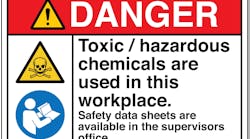Is Your Process Safety Documentation Adequate?
Process documentation and other process safety information (PSI) play a key role in process safety management (PSM). Nearly every governing authority, including the US Occupational Safety and Health Administration (OSHA), and the National Fire Protection Association, as well as insurance providers require process safety documentation.
While requirements differ slightly among industries, the key documents common to most include:
• process description;
• process flow diagram;
• piping and instrumentation drawing (P&ID);
• electrical area classification drawing;
• process hazard analysis (PHA);
• material safety data sheets (MSDS);
• design basis for emergency systems and devices;
• startup/shutdown operating procedures;
• normal operating procedures;
• emergency procedures;
• management-of-change procedure; and
• maintenance records.
Supporting documents may include:
• material and energy balance;
• process chemistry;
• materials of construction;
• equipment arrangement;
• plot plant;
• ventilation design;
• emergency planning;
• upper and lower control limits;
• consequence of process deviation; and
• accident/incident investigation reports.
Additionally, a site should carefully maintain — and periodically update or revalidate — documents pertaining to life safety and building structural design.
Of course, the challenge is ensuring the information you have is adequate and remains that way. So, in this article we'll discuss how to assess and address process documentation.
You should start with the fundamentals. Firstly, senior management should prepare a safety mission statement and safety policy that commits them to the safety of employees and their work environment. Secondly, form a safety committee to manage the diverse aspects of overseeing collection of data and the creation of required documentation. Members should include representatives from management; health, safety and environmental; engineering; maintenance; manufacturing; quality control; and any other departments important to your processes. Thirdly, the safety committee should create a "basis of safety" document as a roadmap for your approach to the design and management of the safety system, ensuring your operations meet the intent of your company's safety policy.
The best approach for any large undertaking is to segment it into manageable pieces. The safety committee should delegate individual document ownership to appropriate departments. When resources are limited, outsourcing the technical drawings to a local engineering firm is a common approach. However, you must start the process internally because no one knows your operation better than your own people. Prepare a list of documents currently available, even if they're old or outdated. Perform a gap analysis to define which documents are missing.
If the resources for document preparation (in terms of time or cost) are a factor, select a smaller "boutique" engineering firm that can perform the work part time at a reduced cost. Alternatively, consider contacting a local university about participating in a cooperative program for third- and fourth-year engineering students. Ensure the students are well supervised to make the most of their four to six months with you.
Once you've got current versions of all the documents needed, store them in a centralized secure location where they are accessible to those who need them. Many companies maintain their documents electronically with date stamps and expiration notices to ensure only the latest information is utilized. The requirement for "as built" documentation is time critical not only for process troubleshooting but also for process hazard assessment, management of change, and capital project implementation. Managers and engineers can spend hours looking for missing documents and, unfortunately, sometimes inadvertently use outdated documents, leading to lost time and potential rework. The role of a document control coordinator is much underappreciated and often is critical to minimizing mistakes and lost efficiencies.
To illustrate what's involved in developing appropriate documentation, let's look at a PHA.
PHA DOCUMENTATION
Spreadsheet-like worksheets alone don't suffice to meet OSHA PSM requirements for covered processes or good engineering practice for noncovered ones, as detailed by the American Institute of Chemical Engineers' Center for Chemical Process Safety (CCPS).
The PHA is a key part of the overall PSI of a process. Unfortunately, the OSHA PSM regulation doesn't specify the need for or format of a formal PHA report but does require documentation of the effort. In addition, under RAGAGEP (Recognized and Generally Accepted Good Engineering Practices) OSHA may interpret the quality of documentation against the CCPS recommendations.
The OSHA PSM regulation requires a plant to keep the PHA and subsequent revalidations for the life of the process. In addition, the site must document all follow-up activities stemming from PHA recommendations and retain the documentation. These retention practices make sense for non-OSHA processes as well. Such retention is important to the periodic PHA revalidation process and management of process changes to ensure that new un-assessed hazards aren't introduced.
The PHA report must contain a number of elements.
Facility siting. OSHA PSM requires PHA reports to include a description of how facility siting was considered, safety-critical findings and recommendations for follow-up activities. Siting checklists such as those of the CCPS are good tools for siting considerations but the checklists alone may not provide enough detail about findings. It's possible that some highly hazardous materials will require additional efforts such as consequence analysis and risk analysis and their results documented or referenced in the PHA report; we recommend including dedicated paragraphs on these.
OSHA expects a plant to specifically address hazards associated with the location of buildings and employees as well as the discharge from emergency relief equipment. Regardless of hazard assessment method applied, the report must indicate where these hazards exist and how they are managed.
Human factors. Discussion of these is another OSHA-PSM-required element; like facility siting, human factors often are covered by a specific checklist. In addition, a site should specifically consider human factors in the PHA worksheets for process safety hazard scenarios regardless of how a scenario is identified. Consistently use phrases such as "human error of omission" or "human error of commission" throughout the worksheet (in the "cause" column) to demonstrate and document consideration of these human factors for operators, mechanics, engineers, management and others. Also, consider hazard and operability studies (HAZOPs) and job safety analysis to uncover potential hazard scenarios caused by human factors. These studies could be follow-up activities recommended by the initial PHA study.
REPORT FORMAT
Numerous references describe formats that should be used for a technical report. The PHA report should follow this general style because it covers a scientific method used to assess process hazards.
The key sections of a PHA report include:
General. The report must have a title page, table of contents and pertinent document-control identifiers specific to site needs.
Executive summary. This section, which generally is limited to one or two pages, provides management with an overview of the report, including scope, methodology, significant findings and the most important recommendations. If the PHA uses risk ranking, this section is used to summarize those discovered scenarios, if any, with the highest risk. The executive summary is where you will find the answers to basic questions of who, what, where, when and how. In most cases, this section is written last.
Introduction. This begins with a description of what the report addresses, including a short process description referencing pertinent detailed PSI such as the operating procedures, process flow diagrams, P&IDs, and MSDS for the process chemicals. It then describes the content to follow.
Scope and objective. Here, detail the process scope and limitations as well as the study objectives, such as meeting the requirements of the OSHA PSM regulation or corporate or site process safety standards or goals. Note if this study targets multiple issues such as safety, environmental, business and operability or only safety ones. Describe specific guidelines used to specify consequence levels and likelihood ratings. Explain how safeguard reliability was evaluated. Refer, as appropriate, to process description documentation in the appendices — but specify scope limitations in this section. Consider including a listing of the modes of operation covered, such as startup, shutdown, emergency shutdown, routine operation and non-routine activities. Point out how utilities were considered because they are an important source of common fault causes for process upset scenarios.
Methodology. This section most commonly contains "boiler-plate" text and covers the method(s) used to analyze the process and identify hazards. It typically describes OSHA-approved methods such as checklists, what-if, what-if/checklist, failure mode and effects analysis, and HAZOP. We recommend including some discussion of why the method is applicable to this PHA with supporting references to the PSI. Explain the risk assessment technique applied, including pertinent consequence descriptors and likelihood levels. Detail the risk rankings as well as actions required for each risk ranking, such as action time schedule allowances. Also, list the team participants with their experience and titles here.
Findings and conclusions. Detail all the most important team findings. Action items may include specific follow-up assignments, most commonly for departments, although individuals may be specified. Tracking of follow-up activities will be easier if the number of assigned groups or individuals is kept to a reasonable number such as three or four. Stress the preliminary nature of findings and that the assigned activities will lead to a risk management plan for follow-up and closure. Such a plan may include detailed consequence analysis and release modeling, layers of protection analysis, or quantitative risk analysis. Export tables from the PHA worksheets with the most critical recommendations. Categorize findings by major topic, such as process node, unit operation or recommendation area (maintenance, operations, engineering, etc.). If risk ranking is used, list intolerable level risks with associated action items. What is intolerable will vary from company to company and generally is risk-matrix specific.
Appendices. These should include:
1. All PHA worksheets edited by the PHA leader and scribe and approved by the PHA team.
2. A complete action-item listing with enough detail to allow those responsible for closure to understand each issue and make appropriate responses. Follow the independent reader (six month) rule: "…include enough detail in each recommendation so that you can grasp the issues after a time delay without additional documentation study or conversations with team members."
3. PSI references (include date and version), such as
• equipment files on items within the PHA scope;
• MSDS for all process chemicals and utility materials;
• process flow diagram and written process description;
• standard operating procedures;
• standard operating conditions;
• P&IDs, if applicable to scope;
• process material and energy balances; and
• listing of study "nodes" or other process subdivisions.
In summary, PHA worksheets alone won't suffice. It's critical to have a formal PHA report that allows a reader to easily grasp the important hazards associated with your process and understand the path forward to ensure appropriate risk management. The pointers provided should enable you to develop a report that stands the test of time, revalidation and auditing.
MANAGING THE PROCESS
The resources required to consistently update and effectively manage all the documents and paperwork related to process safety sometimes result in this work falling off the radar screen. Yet, industrial sites handling and processing hazardous materials always must give process safety and, specifically, life safety top priority. Furthermore, an auditor or a jurisdictional agency relies heavily on a review of available documentation and records in evaluating the safety of your facility.
We can't sufficiently stress the importance of having your process safety documentation up-to-date and readily accessible at all times. Even the largest companies often find gaps in their data due to a multitude of reasons from office relocations to staff changes. The sooner you evaluate the current status of your documentation, the earlier you'll be able to address any potential shortcomings.
DAVID E. KAELIN, Senior, is a process safety specialist for Chilworth Global, Princeton, N.J. BRIAN J. KINGSLEY is manager, consulting and training services, at Chilworth Global, Princeton, N.J. E-mail them at [email protected] and [email protected].

